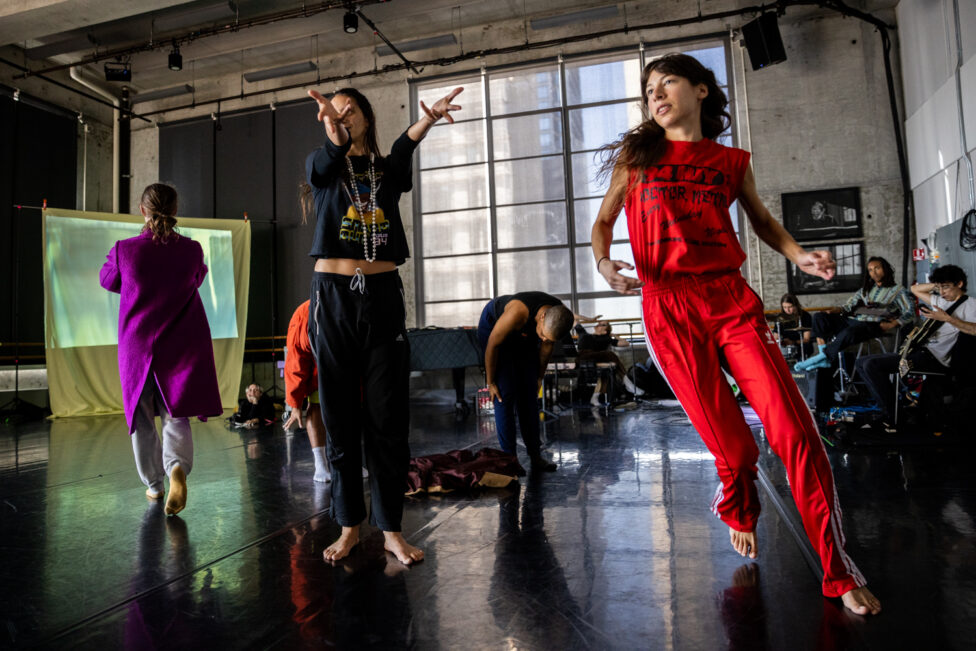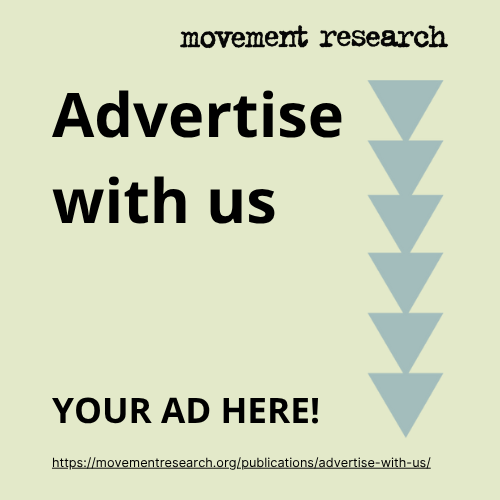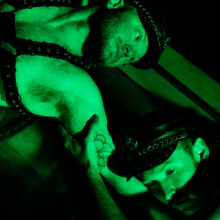We invited Lisa Fagan and the Drama Tops to have a conversation, because we felt a synergy between their work. They both create collaborative performances (often starting in a two-person partnership) that uplift camp, require dancing, and activate persona to ask questions ranging from the earnest to the absurd. Their performances rely on theater, invoke physicality, and call themselves dance.
Lisa is based on the East coast, Drama Tops on the West. They met for the first time at the end of the summer and recorded their conversation in the early Fall. While we certainly hoped that the overlaps we sensed between their works would generate further conversation, we were absolutely thrilled that they said “yes” to meeting and an even bigger “yes” to following the conversation wherever it may lead. After all, you have to stick with the idea so it can reveal another idea.
—Londs Reuter, CC Co-editor
This conversation has been edited for length and clarity.
Lisa Fagan
The thing that really struck me in your work are the transformations that happen inside of each idea. When I’m making something, it’s the thing that excites me and gives the project its heartbeat.
I was struck in Boys, Boys, Boys by the deep and nuanced way you used that mechanism. How one thing occurs, and within the occurrence, another thing starts to happen and takes shape. They really are very organic and amazing. I completely, absolutely adored the opening section, the duet part, the lap dance that turns into wrestling. The beautiful seamlessness before we’re necessarily conscious of it. It’s like: underneath one lies the other. Then another starts to poke its way through. That happened multiple times. It happened throughout the show. The show is like a series of transformations, like the bro handshake that turns into a sex act, and the “pride oreos” becoming the Eucharist, and then the modern dance that turns into a portrait of friendship. Each one surprises you, even though you know that something’s happening under there.
That’s what dance is! Okay, now I’m just fully launching in: that’s what dance has! I refuse to give up on it. Theater needs more of it.
There is no reason to do it, there’s no reason to do the moving unless it reveals, it peels away and reveals something underneath. I’m seeing that very much in your work. I’m thinking about it a lot right now, because myself and my collaborator Lena Engelstein are at the very beginning stage of a new thing. We’re making the material that is dance. And I’m just—Oh I hate it. It’s so horrible. And I know that if I stick in it, it’ll just start to unpeel.
I wonder if that’s how you guys work? In terms of the dance problem. I’ll just call it that. How long does that take? How long do you give it? What happens when you start to anticipate the transformation? You’re hungry to find the thing. I’m desperate to find the thing, so I’m rushing it. Especially because we have a Work in Progress thing coming up. You know how it is.

Elby Brosch
I totally agree with the feeling that the moves don’t matter. So how do you even pick the moves that you’re doing? Everything else defines the meaning… the music, what you’re wearing, what happened before it, what happened after it, everything else, except for the move, actually matters. It totally is a problem. But then I love dancing, and I want dance to be a part of the work because—like you’re talking about—the layers and the multiple meanings happening at once is my favorite thing. In dance, you can have something that’s obvious and have something that’s nuanced percolating through the obvious. Something that one audience member is going to see, and another audience member isn’t going to see. I love all of the layers of it. So much.
I saw that a lot in Deepe Darknesse. I saw layers. Layers that start to click underneath each other. At first, the blackouts and seeing you what you assume is a stagehand that becomes a performer. We see the dimension when you start to repeat material. How it’s different every time you’re doing it. And then, the chaos starts to build, but you still have that memory of clarity from the beginning. The beginning comes back around, and you even comment on it as well. The scaffolding gets built from a dance phrase to a piece of music until it becomes an entire universe that you can travel through and around.
It makes total sense to talk to hear about your process. You start with something and ask: Why do I care about this movement? And then: Oh, this is why I care about it, because I can actually communicate all these different things through it, and it can progress to all these different places.
LF
It’s really wonderful to have you say that, truly, with all authenticity in my heart. I feel extremely excited to meet and talk to other dance artists who think this way.
It’s extremely refreshing to hear we share this sort of predicament. It’s so misunderstood how much time and effort it takes to let the dance be the material. To make it good and nuanced, and then to harvest from it.

Shane Donohue
I love dance because, at its best, it is real people doing real things. And I think dancers approach characterization or character very differently than theater people. Theater people will write a big essay about who they are. For me, I treat a character as another facet of myself that I find through my body.
I like real people dealing with real things, and composition as a way to create puzzles that you can see what humans are going through. Even formalism, even Cunningham is a puzzle. When formalism or classicism is done well, it’s like seeing choreographers and performers dealing with the puzzle of their body. Seeing the real human doing those things is actually what made the heart of Cunningham for me. That’s what I love.
Elby and I take and campify that to show the effort and show how our bodies go through this thing that we made for you. I never feel like I’m performing anything. I always feel like I’m doing what I need to get through it. For Elby, he just smiles the whole fucking time, and it’s so cute. That’s what he needs to get through it. He starts smiling because it’s hard, and he has to be happy. I start to sweat and get mopey.

Elby and I are definitely stuck at this moment with ideas versus the performance of the ideas. We have all these abstract ideas that don’t have any meaning—well, they do have meaning—but they don’t have an arc for us to experience.
We’ve been doing a lot of object work, with tires and inflatable objects and things like that. We tie them to ourselves or stick them to ourselves, and we’re trying to find our body in limitation. But I don’t know how that translates to performance yet, and that’s so frustrating.
LF
Oh, it’s so hard. I love the tire. The tire is so evocative. It’s really amazing.
I agree that encountering the problem of dancing should be interesting.
When I was watching that clip, it was so great to see the tire’s orientation. When you were swinging it, I oriented myself so that it was the wheel of a car, so that Elby was standing. It had a great power of being extremely the object that it is. Everything around it was relative to that; it’s just a very powerful object. Even when you were laying on top of it in sort of an abstract way, you were a car. It dominated the scene in this way that was very effective. I love objects.

SD
In Boys, Boys, Boys, our first piece out of the pandemic, we’d been working on that for a long time. Our timeline for that piece in particular, was so crunched. We worked on it for a very long time, but couldn’t make any decisions. What masculine objects can we have looming over us for 90 minutes, you know? Elby and I are not afraid of an eye-rolly idea.
The tires were up in the ceiling and we had a disco ball hanging inside of them. I think they just started as Dude Stuff. My dad used to work as a mechanic. How can we have one of our mentors? Ben Putnam always talks about what you need to give people in order to take them to a weird place. He’s a drag queen. It’s about “what are you offering your audience so that you can take them somewhere else.”
For this piece DADS, we’ve been spending a lot of time inflating pool toys with our mouths and talking about giant inflatables, talking about becoming something, losing something, inflation and deflation, effort and breath. That’s the baseline of what we’re making. —The moment when your body becomes not you anymore, when you leave yourself and your body is empty, and so, yeah, we’re thinking of stuff like that in terms of inflation and deflation
LF
I mean, tires are something you inflate, which become irrelevant and useless once the air leaves.
EB
Because fatherhood is creation, right? To see how much breath comes out of you every single time you breathe, and have that in the object, and how long you have to wait for that to actually amount to something that is any particular shape.
We’ve talked about grief a lot, because I did lose my father when I was a teenager, and that has hugely shaped me. I want to do a big monologue about my dad, but I really want to do it in a context that doesn’t feel sappy or over the top or performative. I want it to feel like a real experience. Having Shane with me, with the weight of the tire, having a physical experience that requires me to be 100% in the moment and fight, almost fight, to breathe, to speak, to say, the things I feel is helping solve that issue of: how do I talk about this thing that’s very personal and could just be too dramatic? How do we put other things around it that make it less so?

LF
Can you talk more about the stuckness and where you’re at right now with the piece, and what’s your tactic?
EB
We have a lot of ideas that we’re interested in exploring right now. Thematic ideas. Almost too many, right? And we have a lot of movement ideas and object ideas that we’re interested in, and we don’t always feel concrete about how those are related to our thematic ideas, but we’re just trying to trust that they are.
A couple months ago, we kept talking about chaos. We’re so interested in chaos. What does that even have to do with DADS? With fatherhood? Why are we being drawn towards chaos right now? Then, in a therapy session talking about grief, the word chaos came out of my mind, my mouth. I realized, oh, grief is chaotic.
In grief, you have this sense of normalcy and then there’s a huge fracture. It feels surreal. The way that some small thing will trigger a huge emotion in those early moments is totally surreal and chaotic. So, we can trust ourselves that what we’re being drawn to ideas that are connected. We should trust ourselves.
LF
Those are just completely hypothetical thoughts that don’t have any concrete reality, but you bring them into rehearsal every day.
We’re working on the show now, but you’re trying to get to the part where you actually need those other things or those other ideas to happen. But if you’ve already had the idea, it sometimes feels like you’re rigging it, like you’re trying to get somewhere, rather than being inside the generative material.
How long have you been working on this?
EB
Kind of sporadically, since November of last year…
SD
…no, March of 2023.
EB
I guess I’ll concede that. Yeah, a two week residency, and then we didn’t work on it again for like, nine months.
LF
That desire to start making connections. I guess oftentimes, I just have to trust that the stuff is still there. That it didn’t go anywhere. I don’t have to touch it every time we rehearse or even every time we have a residency. You just kind of put those things aside. And that can be a really hard middle place.
There are things in the room with you, and it could be that could be the thing or it could not. It could disappear forever! Which is kind of where we’re at.









